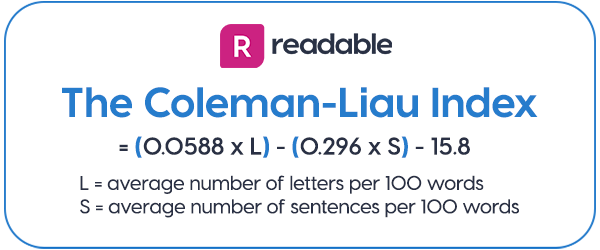What is the Coleman-Liau Index?
Coleman-Liau is a readability formula which shows the reading level of a text. It uses sentences and letters as variables.
Where did the Coleman-Liau Index come from?
The index was created by Coleman and Liau in 1975. They were critical of syllabic counting techniques. It is hard for machine tabulation to detect syllabic nuances. Now that readability is used in digital, this method has advanced.
According to Coleman and Liau:
"Word length in letters is a better predictor of readability than [...] in syllables.”
How does the test work?
The building blocks used in Coleman-Liau are:

A score of 6 is 6th grade in the US schooling system. If you’re writing for the public, you should aim for a grade level of around 8-10.
When is the test most useful?
Coleman-Liau is widely used in schools. Educators can benefit from Coleman-Liau. It can provide an easy measure of readability. It has also been used for medical documents. It is often used alongside other formulas.
Coleman-Liau can provide value in Western-European texts. For these texts, Coleman-Liau can be used for comparison. There are some limitations outside of English. Importantly, the formula is standardised for English language texts. Coleman-Liau is used to evaluate the length of words. This can complicate language such as German. German uses more compounded words. For example, for indicators of tense.
This means Coleman-Liau is better used in English. But, it can be used for comparative purposes.
An interesting use case for Coleman-Liau measure is in Law. Here, it has been used to explore judicial opinions. These are written by judges during a court case. They provide a resolution to a legal dispute.
Reports show that judges can shrewdly write less readable opinions. This is because writing less readable opinions discourages backlash.
With its range of uses, Coleman-Liau helps you to reduce word length.
Sources: researchgate.net, semanticscholar.org, faculty.cs.byu.edu, wiley.com, sciencedirect.com, anthology.aclweb.org, mortengoodwin.net, gvpt.umd.edu

